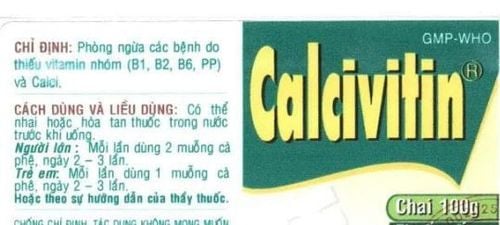This is an automatically translated article.
Wokadine is a solution used to disinfect skin and mucous membranes, used to support in cases of inflammation caused by infection with pathogenic microorganisms. To understand more about the drug and how to use it safely, please refer to the information below.
1. What is Wokadine?
Wokadine medicine has the main ingredient Povidon iodine, bottled in 100ml, this is a form of antiseptic solution, prepared with different content of ingredients.For Wokadine 1% is used to rinse the mouth, Wokadine 10% is used to disinfect the skin.
Povidone iodine can be absorbed systemically depending on the area and condition of drug use such as using on large areas, skin, mucous membranes, wounds, cavities in the body.
Povidone is used as an iodine carrier. When used, povidone iodine solution will release iodine gradually in the skin or mucous membranes, thus prolonging the antiseptic effect to kill bacteria, fungi, viruses, protozoa, cocoons and spores. Although the drug is less effective than preparations containing free iodine, it is less toxic, because the amount of free iodine is lower.
2. What does Wokadine do?
Wokadine is prepared in the form of a 1% solution of Povidone Iodine, which is used to gargle and gargle in case of bacterial infection in the oropharynx. The drug helps to disinfect the mucosal surface of the oropharynx, limiting the growth of pathogenic microorganisms. Especially when there are wounds, sores or before an oral procedure.For the dosage form Povidone iodine 10% is used to disinfect the skin, not to rinse the mouth. Effective to avoid infections, viruses, fungi ... causing disease on open wounds, burns.
Some specific cases can use Wokadine such as:
Bacterial glossitis or candida. Inflammation of the oral mucosa. Pharyngitis, tonsillitis. Support in the treatment of viral infections such as colds, Covid... Open wounds, burns... Disinfect skin before surgery, disinfect hands to clean medical staff before surgery.
3. When should Wokadine not be used?
Do not use Wokadine in the following cases:
People with a history of hypersensitivity to any ingredient of the drug. Do not use this medicine for people with a history of hypersensitivity to iodine. Contraindicated for infants up to 2 years old, pregnant women. Do not use on areas that are bleeding heavily or deeply damaged. Do not use this solution for ear drops when the eardrum is punctured. Patients with thyroid problems such as hyperthyroidism should not use it. People who are taking radioactive iodine to treat thyroid disease should also not use it.
4. How to use Wokadine
For Wokadine 1%: This is a mouthwash solution, so you should use it by rinsing your mouth as follows:
Take a sufficient amount of Wokadine solution or can be diluted with a ratio of 1:1, then rinse and rinse your mouth. throat within 30 seconds. After rinsing the mouth and throat, discard the amount of medicine solution. This solution only gargles and gargles you do not swallow this solution. You can gargle or gargle 2 to 4 times a day, depending on the status of the infection. Do not use for more than 14 days unless indicated. For Wokadine 10% solution: Used to disinfect the skin.
Disinfection directly on small wounds or preferably diluted with clean water if used on a large scale. Especially using large burns or cleaning the genitals after giving birth with an episiotomy... Use every 2 days, depending on the extent of the damage, the number of times of use can be increased. Do not use for more than 14 days without consulting a doctor.
5. Wokadine side effects
This preparation may cause local irritation when used, although less irritating than free iodine.
For Wokadine 1% usually causes local reactions, because it is very rare that iodine is absorbed systemically.
Common side effects such as itching, redness of the mucous membranes, blistering. Iodine allergy, petechiae, salivary gland inflammation, but with a very low rate. Very rarely causes anaphylaxis reactions, but if encountered, it can be dangerous for the patient. Need to be taken to the nearest medical facility when there are symptoms such as hypotension, shortness of breath, edema of the throat... In case of external use (Wokadine 10%) with large area of use, large wounds can absorb steam. systemic absorption and cause side effects such as: Thyroid effects such as hypothyroidism or thyroid storm; cause metabolic acidosis; hypernatremia and impaired renal function; seizures; convulsions ; neutropenia; skin irritation...
If you see local irritation when using, you should stop taking the drug and consult your doctor or pharmacist for advice on changing the appropriate drug. Other side effects occur you should also consult your doctor, for appropriate treatment.
6. Some things to pay attention to when taking Wokadine
You need to pay attention to the history of allergy to the active ingredients in the product. Carefully read the instructions on how to take the medicine on the leaflet. Note: Because Wokadine solution has many different concentrations, you need to be very careful to choose the right solution that can gargle, this solution usually has a low concentration of 1%, absolutely do not use 10% solution. to gargle. This solution is an antiseptic solution, only used if it is contaminated with pathogenic microorganisms. It should not be used as a substitute for another safe, daily mouthwash and should not be used for more than 14 days in a single course of treatment. Pregnant or lactating women: When used, can cause systemic absorption and cross the placenta, excreted in milk, affecting the fetus or nursing infant. Therefore, it should be avoided for this object when it is not necessary, especially pregnant women in the last 6 months of pregnancy. Drug interactions: Avoid using at the same time with many different antiseptic solutions; Do not use with soaps, solutions or ointments containing mercury. Storage: keep the medicine in a dry place, away from direct light, at a temperature below 25 degrees Celsius. Keep out of reach of children. Hopefully, with the above information about the drug, you already know the uses, how to use and what to keep in mind when using Wokadine. This antiseptic solution is used very commonly but also needs to be used with caution, should not be overused.













